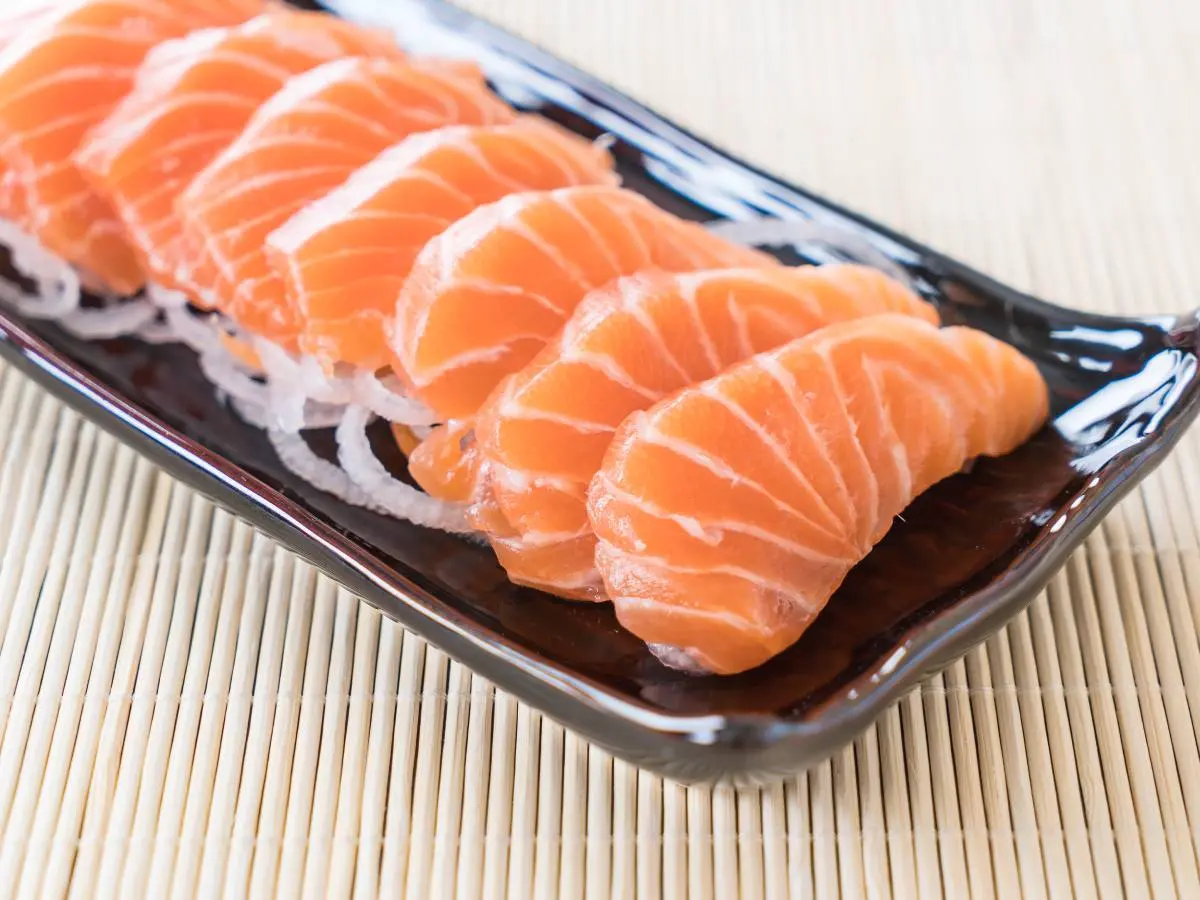Embarking on the journey of preparing salmon sashimi at home can be both an exciting and daunting endeavor. The allure of this delicately sliced, raw salmon dish, a staple in Japanese cuisine, lies not only in its exquisite taste but also in the artistry of its preparation. However, the paramount concern when dealing with raw fish, especially salmon, is safety. This comprehensive guide aims to demystify the process, ensuring that your home-prepared salmon sashimi is not only delicious but also safe to consume. From selecting the right type of salmon to understanding the critical steps in preparation, we’ll cover all you need to know to enjoy this delicacy without worry. So, let’s dive in, shall we?

Understanding Salmon Sashimi Safety
The Importance of Safe Sashimi Preparation
When it comes to enjoying salmon sashimi, the excitement should never be dampened by concerns over food safety. It’s crucial, then, to understand the risks associated with consuming raw salmon. The primary concern? Parasites. These unwelcome guests can pose significant health risks, making the proper preparation of sashimi not just a matter of taste but of safety.
However, fear not! With the right knowledge and techniques, you can mitigate these risks and ensure that your sashimi is both safe and scrumptious. It all starts with choosing the right salmon and understanding the processes that make it safe for raw consumption. How long to bake salmon at 400
Overview of Risks Associated with Raw Salmon
Raw salmon, like many types of seafood, can harbor parasites and bacteria. The most common culprits include Anisakis, a type of nematode that can cause severe gastrointestinal distress, and Vibrio, a bacteria that can lead to food poisoning. Thus, ensuring the safety of your salmon sashimi involves neutralizing these potential threats.
But here’s the kicker: not all salmon is created equal when it comes to sashimi preparation. The distinction between farmed and wild salmon, the conditions under which the salmon was raised and caught, and the subsequent handling and processing all play pivotal roles in determining the safety of the salmon for raw consumption.
In the following sections, we’ll guide you through selecting the best salmon for your sashimi, detail the steps for safe preparation, and share some tips for serving and enjoying your homemade delicacy. By adhering to these guidelines, you’ll be well on your way to safely enjoying salmon sashimi that rivals even the best sushi restaurants. So, let’s get started on this culinary adventure, ensuring that every slice of salmon is a testament to both your skill and diligence in preparation.
Choosing the Best Salmon for Sashimi
Farmed vs. Wild Salmon: A Safety Perspective
When it comes to selecting the perfect salmon for your sashimi, the debate between farmed and wild salmon takes center stage. Each has its pros and cons, but from a safety perspective, farmed salmon often emerges as the more reliable choice for raw consumption. Why, you ask? Well, it boils down to control and consistency. Farmed salmon are raised in controlled environments, which means their diet, health, and living conditions are monitored to reduce the risk of parasites and diseases. On the flip side, wild salmon, while praised for its robust flavor and natural diet, can be a bit of a gamble due to the unpredictability of its environment.
However, it’s not just about farmed versus wild. The real secret sauce to safety lies in the term “sushi-grade.” This unofficial designation implies that the salmon has been frozen to kill parasites, making it safe for raw consumption. But remember, not all salmon labeled as sushi-grade meets the same standards, so it’s crucial to buy from reputable sources.
Identifying Sushi-Grade Salmon
So, how can you ensure you’re getting the real deal? First off, engage with your local fishmonger or specialty seafood market. These folks are usually clued up on the origins and handling of their fish and can guide you towards the best choices for sashimi. Don’t shy away from asking questions about the salmon’s source, how it was raised, and whether it has been frozen to the appropriate standards for killing parasites.
Where to Buy Your Salmon
Your best bet for finding sushi-grade salmon is at a trusted local fish market or a well-regarded specialty store. These places prioritize the freshness and safety of their seafood, ensuring that their sashimi-ready salmon is up to snuff. Avoid the temptation of supermarket salmon, unless it’s explicitly labeled for raw consumption. Remember, the extra mile you go in selecting your salmon is a testament to your commitment to both quality and safety.
In summary, the journey to the perfect salmon sashimi starts with selecting the right fish. Whether you opt for farmed or wild, the key is to ensure it’s sushi-grade and sourced from a reputable supplier. Armed with the right salmon, you’re well on your way to creating a sashimi experience that’s not just delicious but also safe and memorable. Stay tuned for the next part, where we’ll dive into the nitty-gritty of preparing your salmon for that perfect slice of sashimi. How long does it take to cook salmon at 400?
Safe Preparation of Salmon Sashimi
Ingredients and Quantities
Before we dive into the preparation process, let’s ensure we have everything we need. For your salmon sashimi, the ingredient list is refreshingly short, emphasizing the importance of quality and simplicity in Japanese cuisine. Here’s what you’ll need:
- Fresh farmed salmon (Sushi-grade, remember!): 1 pound
- Salt: 1 teaspoon per pound
- Freezer bag: 1 (Ziplock or similar to prevent freezer burn)
- Optional for serving: Yuzu aioli (a mix of yuzu hot sauce and olive oil for a citrusy kick)
Step-by-Step Preparation Guide
- Selecting Your Salmon: Start with a 1-pound fillet of sushi-grade farmed salmon. This quantity is ideal for a small gathering, ensuring everyone gets a taste of your culinary prowess.
- Prepping the Salmon: Pat the salmon dry with a paper towel. Sprinkle 1 teaspoon of salt per pound evenly over the fish. The salt not only seasons the salmon but also helps draw out moisture, a key step in preparing it for freezing.
- Rinsing: After letting the salmon sit for 20 minutes, rinse it under cold running water. This step removes the salt and any surface impurities, preparing it for the next crucial phase.
- Drying and Bagging: Pat the salmon dry once more, then place it in your freezer bag. Removing as much air as possible, seal the bag tightly to prevent freezer burn, which can affect the salmon’s texture and taste.
- Freezing: Freeze the salmon for at least 7 days at -4°F (-20°C). This duration and temperature are critical for killing any parasites, ensuring your sashimi is safe to eat.
- Thawing: When you’re ready to enjoy your sashimi, transfer the salmon from the freezer to the refrigerator the night before. This slow thawing process helps preserve the texture of the fish.
- Slicing and Serving: Before slicing, take the salmon out of the refrigerator and pat it dry. Slice thinly against the grain and serve immediately. For an added touch, consider pairing it with sushi rice, wasabi, soy sauce, or the optional yuzu aioli for a burst of flavor. Is it better to bake salmon at 350 or 400?
Freezing Process Explained
The freezing process is non-negotiable when it comes to preparing salmon sashimi at home. By freezing the salmon at -4°F (-20°C) for at least 7 days, you’re employing a method widely used in sushi restaurants worldwide to ensure the fish is safe for raw consumption. This step effectively eliminates the risk of parasites, making your sashimi experience worry-free.
Thawing and Serving Suggestions
Thawing your salmon correctly is just as important as the freezing process. A slow thaw in the refrigerator ensures that the texture of the salmon remains intact, preserving its delicate flavor. When it comes to serving, simplicity is key. Thinly sliced salmon, a dab of wasabi, a splash of soy sauce, and perhaps a drizzle of yuzu aioli can elevate your sashimi to new heights.
In crafting salmon sashimi at home, the journey from selection to serving is filled with steps that, while simple, are crucial for ensuring both safety and quality. By following this guide, you’re not just preparing a meal; you’re creating an experience that celebrates the beauty of raw salmon, safe in the knowledge that every slice is as safe as it is delicious. Stay tuned for our next installment, where we’ll explore additional safety measures to further ensure your sashimi is perfect in every way. How do I know when salmon is done baking?
Additional Safety Measures
Ensuring the safety of your salmon sashimi doesn’t stop at selecting the right fish and following the freezing and thawing process. There are additional steps and precautions you can take to further minimize any risk and ensure your dining experience is both enjoyable and safe.
The Role of Freezing in Parasite Elimination
We’ve already touched on the importance of freezing your salmon to eliminate parasites, but let’s delve a bit deeper into why this step is so crucial. Parasites, such as Anisakis, can pose significant health risks if consumed. The freezing process, when done correctly at -4°F (-20°C) for at least 7 days, is recognized by food safety authorities, including the FDA, as an effective method to kill these parasites. This makes freezing not just a recommendation but a critical step in the preparation of salmon sashimi.
Vinegar Soak: An Additional Precaution?
Some enthusiasts and experts suggest an additional step to enhance safety: a vinegar soak. Soaking the salmon in a diluted vinegar solution (using rice vinegar or white vinegar) for a few minutes before the freezing process can add an extra layer of protection against surface bacteria. The acidity of the vinegar creates an inhospitable environment for bacteria, further reducing the risk of foodborne illness. However, it’s important to note that while this step can be beneficial, it should not replace freezing as the primary method of parasite elimination.
Serving and Enjoyment
Once you’ve taken all the necessary safety precautions, it’s time to focus on the most enjoyable part of the process: serving and savoring your homemade salmon sashimi.
Creative Serving Suggestions
Presentation plays a big role in the enjoyment of sashimi. Arrange your thinly sliced salmon on a chilled plate in an appealing manner. Garnishes such as thinly sliced lemon, a sprinkle of finely chopped chives, or a side of pickled ginger can add color and enhance the flavor profile of your dish. For those who enjoy a bit of heat, a small dollop of wasabi on the side is a must. And don’t forget the soy sauce for dipping! What temperature and length to cook salmon?
Pairing with Sides and Condiments
Sashimi is often enjoyed as part of a larger meal. Consider pairing your salmon with other dishes that complement its delicate flavors. Sushi rice, lightly seasoned with vinegar, sugar, and salt, can be a great accompaniment, allowing guests to create their own bites of sashimi and rice. A simple salad dressed with a light vinaigrette or a miso soup can round out the meal, offering a balance of flavors and textures.
Creating salmon sashimi at home is a rewarding experience that combines the art of cooking with the pleasure of dining. By following the guidelines outlined in this guide, you can ensure that your sashimi is not only delicious but also safe to eat. Remember, the key to great sashimi lies in the quality of the salmon, the precision of the preparation, and the care taken in serving. With these elements in place, you’re ready to enjoy a truly authentic sashimi experience right at your own dining table.
Stay tuned for our next section, where we’ll explore frequently asked questions about salmon sashimi, providing you with even more insights to enhance your culinary journey.


